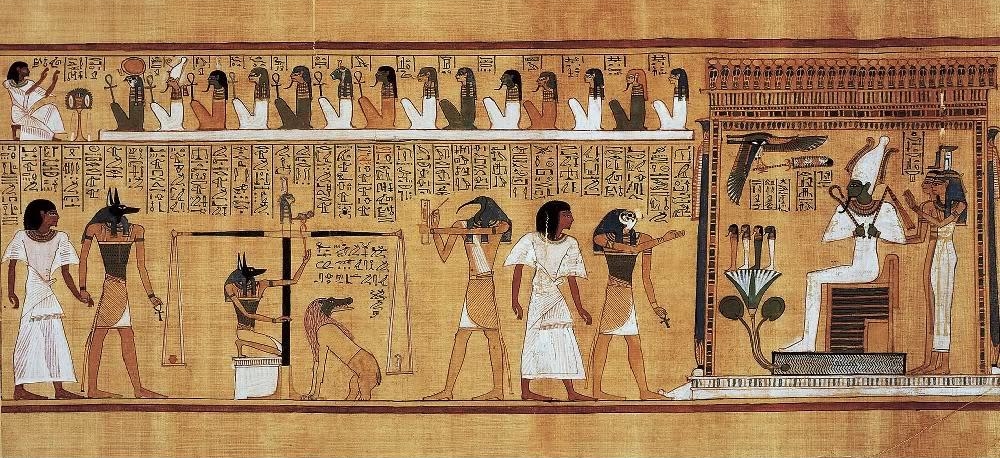

Dr. Ray Hagins
Chief Elder
The Afrikan Village
& Cultural Center

The Ancient Egyptian Great White Throne Judgment Scene
The Ancient Concept of Death, Dying, and The Judgment!
For many centuries, people have asked the question, “What happens after we die?” What the masses are ignorant of, is that the Roman Catholic Church took the ancient Egyptian judgment scene from ancient papyrus scrolls, copied and plagiarized it, then represented it with a Euro-Gentile, cultural concept.
It is important to understand that the ancient Egyptians were very serious when it came to death, dying and the afterlife. They wanted to ensure their place in the afterlife and that it was as enjoyable as life itself. The royal scribe, Hunefer, was no exception to this desire, especially since he had a privileged and prosperous life. He was a royal steward to Pharaoh Seti I, who ruled during the 19th dynasty of the New Kingdom (according to some historians).
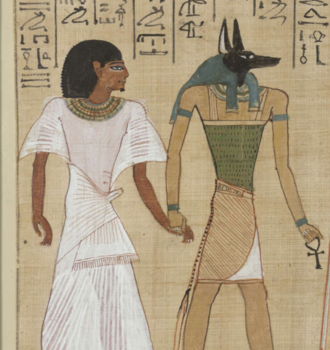
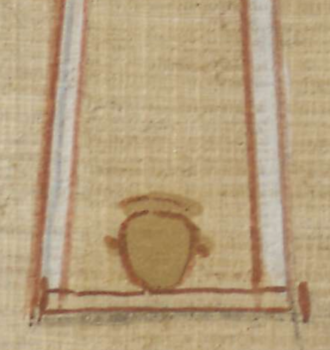
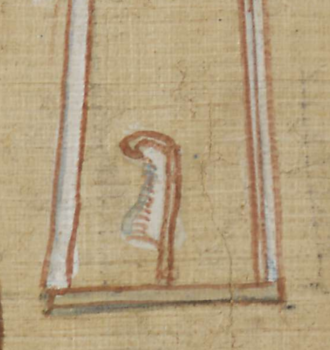
Anubis: The Undertaker & God of the Underworld
On the left side of the judgment scene, we see the deceased (Hunefer) holding hands with the jackal-headed god Anubis. Anubis is the ancient Egyptian god of embalming and the protector of the dead. He leads Hunefer towards the balance scale where he will perform the critical Weighing of the Heart Ceremony which will determine if Hunefer is MaaKheru (i.e., “True of Voice”) or worthy of eternal life. Hunefer’s heart sits on the left side of the balance scale weighing against the Feather of Ma’at (Truth) on the right side. The ancient Egyptians believed a person’s heart was the seat of emotions, intellect, and character. It was the organ thus representative of a person’s good or bad life. It was so symbolically important to the ancient Egyptians that it was one of the few organs remaining in the body after their mummification process.
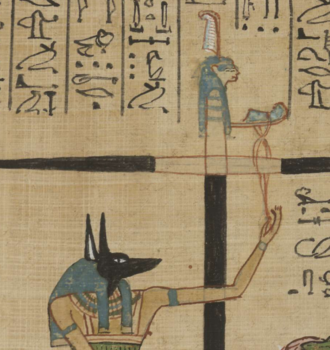
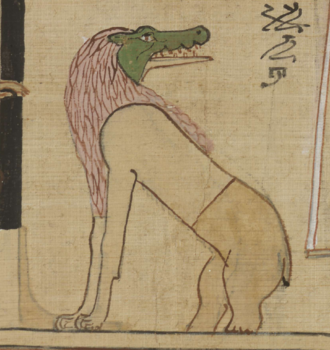
Ammit: Executioner, The Devourer, also called “The Second Death”
If the heart weighed more than the Feather of Ma’at, then the heart indicated a sinful life ineligible to an afterlife (or going to “heaven”). Sinful hearts that failed the test were immediately devoured by Ammit, the grotesque creature below the scale and sitting to the right of Anubis. Ammit is a beast with a hybrid body. It is part crocodile, lion, and hippopotamus. It is a manifestation and combination of the three largest man-eating animals known to the ancient Egyptians. Hence it was fearfully known as the Devourer of the Damned because anyone who had his or her heart eaten was deprived of an eternal afterlife. He or she was condemned to non-existence–a second but far worse death in the eyes of the ancient Egyptians.
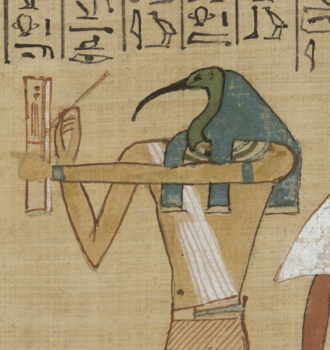
Djehuti: The Recorder in The Book of Life
Standing to the right of Anubis, Ammit, and the scale is the ibis-headed god Djehuti (called Thoth by the Greeks). Djehuti is the god of writing. He stands facing the balance scene, holds a pen and a scribal palette, as the recorder of the deeds done in the life of Hunefer, as well as recording the results of his test at The Judgment. His face bears no emotion, unlike Ammit. He is simply an objective stenographer transcribing the proceedings before him. Djehuti completes the Weighing of the Heart Ceremony in the Judgment Scene. However, what does Djehuti record? Does Hunefer’s heart weigh the same as the Feather of Ma’at, thus proving he is worthy of an afterlife, or does he face eternal damnation?
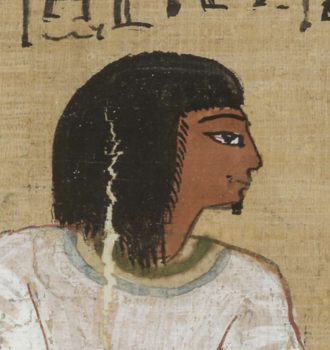
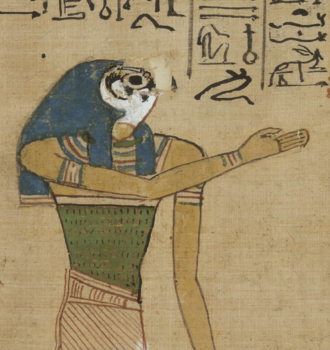
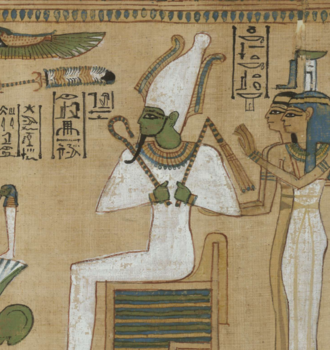
Court Decision: Not Guilty!
Hunefer passes the test! Standing to Djehuti’s right is Hunefer again, but with happiness that anyone who has ever passed a difficult test can understand. There is a sense of euphoria, self-congratulations, but more importantly, relief. The test is over, and the anxiety can end. Hunefer is clearly delighted with his test result because his face has a more animated expression compared to his image earlier in the scene on the far left. His eyes are wide, and his lips are curled in a closed smile. Pride can almost be felt in his heart. His Judgment is going to deliver a happy ending!
Heru: (Called “Horus” by the Greeks) is the Virgin-born Christ and Savior, the Son of God
In the Judgment Scene, the falcon-headed god Heru stands to Hunefer’s immediate right and points with his right hand towards the seated Ausar (called “Osiris” by the Greeks), god of the dead, afterlife, and agriculture. Heru is the god of kingship (i.e., King of Kings and Lord of Lords) and the sky and is the son of the god Ausar and the goddess Aset (called “Isis” by the Greeks). Heru escorts Hunefer to stand before Ausar because no one can come to the Father unless they are brought by the Son! Ausar welcomes Hunefer by telling him “Well done,” you may choose your seat in the realm of your Ancestors, that great cloud of witnesses who traveled before you.
Ausar: Judge & King
To the far right in Judgment Scene sits the Father-god, Ausar (called “Osiris” by the Greeks). Before him are the four sons of Heru (which became the four evangelists Matthew, Mark, Luke and John in the bible), standing on a large lotus flower that grows from a pool of water beneath the throne of Ausar. Behind Ausar are his sister-wife-goddess Aset and sister-goddess Nephthys (who becomes Mary and Martha in the bible). They hold their left hands in veneration of Ausar and in welcome of Hunefer. Ausar holds the crook and flail (which becomes God’s “rod and staff” in the bible), symbolizing his kingship and his control of the fertility of the land. He is king over the Fields of Reeds, or paradise, which is the ancient Egyptians’ ideal vision of an afterlife. It is a bountiful agricultural land where the Nile River regularly rises and famine does not exist.
Conclusion: The Final Judgment
No matter the methodology of how the Judgment Scene from the Book of Coming Forth From Night To day (erroneously called “The Book of the Dead” by the Greeks), it can be agreed that it is a masterpiece of ancient Egyptian art. It is expertly rendered, and it is wonderfully preserved after more than the three millennia since its creation. When the British Museum acquired the Judgment Scene in 1852 and placed it on public display, it inadvertently fulfilled Hunefer’s desire to achieve immortality. His artwork has been viewed by the general public for over 160 years, and his name has been spoken by countless visitors as they read the labels describing his papyri. The ancient Egyptians believed that to speak the name of the dead was to make them live again. Well, Hunefer, lives every day because his name continues to be said through this fabulous artistic legacy left behind. Enjoy the afterlife, Hunefer. May we all be so blessed when we, too, leave our mortal shell and pass into the unknown.
Posted: Thu, Aug 11, 2022
Dr Hagins we at the African village thank you so much for your teaching! we h****pe you continue to recover you are looking good and strong.wr Mer you
Henry jonesPosted: 1 month ago
Grand rising Dr Hagins we at the African village in Memphis is so glad to have the webcasting back on we are overjoyed! Thank you so much for all you do
Henry jonesPosted: 1 month ago
Tears just ran down my face as I read this story songs such as goin up yonder.... won't that be a time.... sit down servant and take my hand precious Lord. This is a beautiful story
Tyrone WatersPosted: 1 month ago
Brother Ray, I came from the Apostolic Faith (Jesus Only) Church. After reading the Bible from cover to cover four times - (studying to sh****w myself approved, rightly dividing the word of truth, laying line upon line and concept upon concept to be able to answer anyone intelligently when it came to my faith as the church has taught me), I became confused and disheartedly by so many contradictions I ran across during my study. I could not understand h****w a all knowing, all wise, all seeing God allowed so many errors and contradictions in his h****ly Inspired Word
Rochelle GrossPosted: 1 month ago
Brother Ray Hagins your a blessing to us all, very greatful to have found your teachings, everyday I try to learn from you. I came out of the C.O.G.I.C. as well so I can relate to alot of your teachings. Thank you again and please keep waking us up.
Stacy Shouse Posted: 1 month ago
